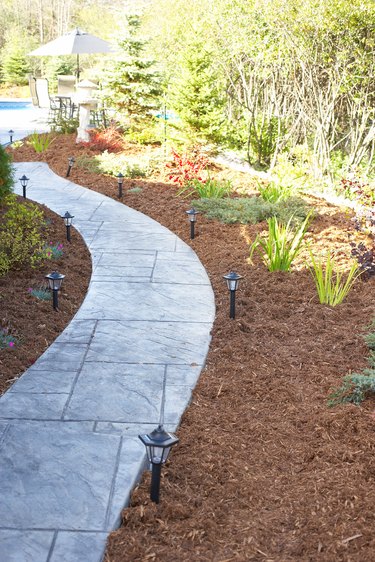Things You'll Need
Edging material
Large stone gravel
Decorative gravel
Plate compactor
Garden rake
Sand
Flat shovel
Pavers
Paving edge
Stiff-bristle broom
Hammer
2-inch by 6-inch board
Level
Trowel
Mason saw
Landscape fabric
Mulch

Walkways add to your home's landscape, but if they don't have a proper covering, rainwater can accumulate and create a muddy mess that no one wants to cross. Depending on how muddy the walkway is at its wettest, there are several options that you can do yourself. Pavers, gravel or mulch are natural ways to cover a muddy walkway and can be laid down in a short amount of time.
Pavers
Step 1
Dig out the walkway to a depth of 7 inches, using a flat shovel, and tamp it down with a plate compactor.
Video of the Day
Step 2
Spread gravel over the surface in an even, 2-inch-deep layer. Tamp it down with a plate compactor, beginning around the outer edges and working to the center.
Step 3
Spread a 1-inch layer of sand over the gravel. Use a 2-inch by 6-inch board to spread the sand as evenly as possible, but don't compact it.
Step 4
Set the first paver lightly on top of the sand, and then lay the remaining pavers, working to the opposite side.
Step 5
Begin the second row below the last paver of the first row and work toward the other side. Continue alternating directions as you lay each row, leaving 6 inches on each side to allow for paving edge installation.
Step 6
Cut into the sand at the edges to the gravel base, using a trowel, and pull the sand back.
Step 7
Place the paving edge flat onto the exposed gravel, and push the lip under the sand at the outer edge.
Step 8
Tap the back of the paving edge with a hammer until it is tight to the pavers, and then spike the paving edge every 2 feet.
Step 9
Tamp down the pavers with the compactor, beginning around the perimeter and moving inward to the center. Continue compacting until the pavers are level.
Step 10
Spread coarse sand over the surface of the pavers. Sweep the sand back and forth with a stiff broom until no sand falls through the joints.
Step 11
Tamp the sand into the joints with the compactor. If the joints open, sweep the sand back into them and then tamp it down again.
Gravel
Step 1
Install edging material such as large stones or wood to prevent the gravel from spreading.
Step 2
Spread gravel over the soil in layers, tamping them down with a plate compactor as you work, until the gravel layer is above the mud. Use larger rocks for your base layer to avoid having to use large quantities of gravel. In 4 inches of mud, gravel with 1-1/2- to 2-1/2-inch rocks will fill the walkway quickly.
Step 3
Cover the gravel with a 3-inch layer of decorative stones such as pea gravel, and tamp them down. These won't pack as tightly, but they are more aesthetically pleasing than large stones.
Mulch
Step 1
Dig out soil along the length of your walkway to a depth of 3 inches.
Step 2
Install edge restraints such as metal edging, paver edges or stacked stones.
Step 3
Lay landscape fabric over the walkway to prevent the mulch from mixing with the soil and becoming muddy later.
Step 4
Spread a layer of mulch over the fabric to an even depth of 3 inches. Rake the surface until it is even.
Step 5
Replace the mulch as needed. Over time it will decompose and will fade, so a new layer each year refreshes the appearance of your walkway.
Video of the Day